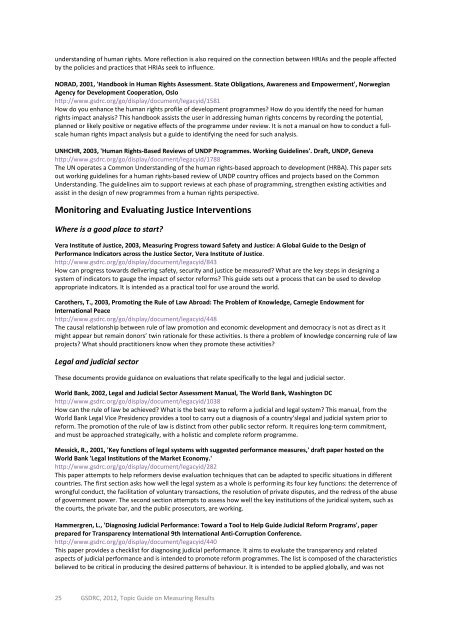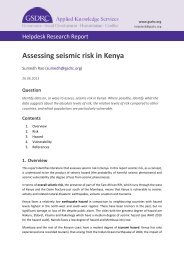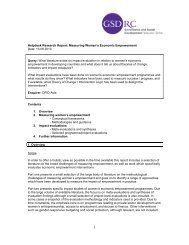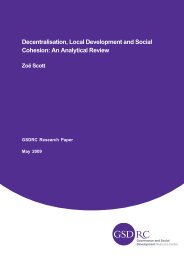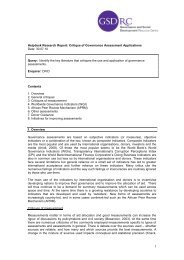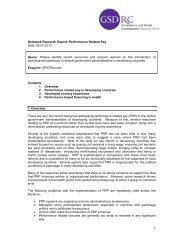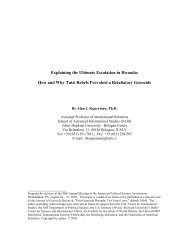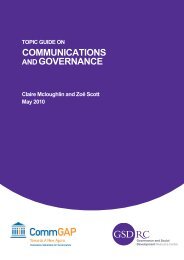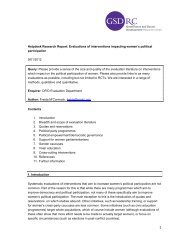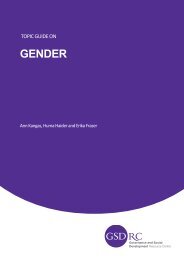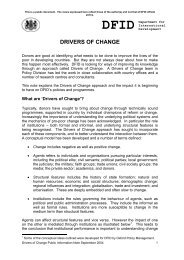understanding of human rights. More reflection is also required on the connection between HRIAs and the people affectedby the policies and practices that HRIAs seek to influence.NORAD, 2001, 'Handbook in Human Rights Assessment. State Obligations, Awareness and Empowerment', NorwegianAgency for Development Cooperation, Oslohttp://www.gsdrc.org/go/display/document/legacyid/1581How do you enhance the human rights profile of development programmes? How do you identify the need for humanrights impact analysis? This handbook assists the user in addressing human rights concerns by recording the potential,planned or likely positive or negative effects of the programme under review. It is not a manual on how to conduct a fullscalehuman rights impact analysis but a guide to identifying the need for such analysis.UNHCHR, 2003, 'Human Rights-Based Reviews of UNDP Programmes. Working Guidelines'. Draft, UNDP, Genevahttp://www.gsdrc.org/go/display/document/legacyid/1788The UN operates a Common Understanding of the human rights-based approach to development (HRBA). This paper setsout working guidelines for a human rights-based review of UNDP country offices and projects based on the CommonUnderstanding. The guidelines aim to support reviews at each phase of programming, strengthen existing activities andassist in the design of new programmes from a human rights perspective.Monitoring and Evaluating Justice InterventionsWhere is a good place to start?Vera Institute of Justice, 2003, Measuring Progress toward Safety and Justice: A Global Guide to the Design ofPerformance Indicators across the Justice Sector, Vera Institute of Justice.http://www.gsdrc.org/go/display/document/legacyid/843How can progress towards delivering safety, security and justice be measured? What are the key steps in designing asystem of indicators to gauge the impact of sector reforms? This guide sets out a process that can be used to developappropriate indicators. It is intended as a practical tool for use around the world.Carothers, T., 2003, Promoting the Rule of Law Abroad: The Problem of Knowledge, Carnegie Endowment forInternational Peacehttp://www.gsdrc.org/go/display/document/legacyid/448The causal relationship between rule of law promotion and economic development and democracy is not as direct as itmight appear but remain donors’ twin rationale for these activities. Is there a problem of knowledge concerning rule of lawprojects? What should practitioners know when they promote these activities?Legal and judicial sectorThese documents provide guidance on evaluations that relate specifically to the legal and judicial sector.World Bank, 2002, Legal and Judicial Sector Assessment Manual, The World Bank, Washington DChttp://www.gsdrc.org/go/display/document/legacyid/1038How can the rule of law be achieved? What is the best way to reform a judicial and legal system? This manual, from theWorld Bank Legal Vice Presidency provides a tool to carry out a diagnosis of a country’slegal and judicial system prior toreform. The promotion of the rule of law is distinct from other public sector reform. It requires long-term commitment,and must be approached strategically, with a holistic and complete reform programme.Messick, R., 2001, 'Key functions of legal systems with suggested performance measures,' draft paper hosted on theWorld Bank 'Legal Institutions of the Market Economy.'http://www.gsdrc.org/go/display/document/legacyid/<strong>28</strong>2This paper attempts to help reformers devise evaluation techniques that can be adapted to specific situations in differentcountries. The first section asks how well the legal system as a whole is performing its four key functions: the deterrence ofwrongful conduct, the facilitation of voluntary transactions, the resolution of private disputes, and the redress of the abuseof government power. The second section attempts to assess how well the key institutions of the juridical system, such asthe courts, the private bar, and the public prosecutors, are working.Hammergren, L., 'Diagnosing Judicial Performance: Toward a Tool to Help Guide Judicial Reform Programs', paperprepared for Transparency International 9th International Anti-Corruption Conference.http://www.gsdrc.org/go/display/document/legacyid/440This paper provides a checklist for diagnosing judicial performance. It aims to evaluate the transparency and relatedaspects of judicial performance and is intended to promote reform programmes. The list is composed of the characteristicsbelieved to be critical in producing the desired patterns of behaviour. It is intended to be applied globally, and was not25 <strong>GSDRC</strong>, 2012, Topic Guide on Measuring Results
written with any specific legal system or tradition in mind. It aims to capture universal factors that will help identify real orpotential problems in judicial operations.<strong>GSDRC</strong>, 2009, ‘Institutional Assessment of the Police and Justice Sectors’, Helpdesk Research Report, <strong>GSDRC</strong>,Birminghamhttp://www.gsdrc.org/go/display&type=Helpdesk&id=515This report includes coverage of a number of donor designed frameworks for assessing the policing and justice sector.According to much of the general academic and policy literature on SSAJ programmes, substantial reform of the policeforce is only possible when reform of the justice system is administered at the same time. However, whilst the underlyingprinciples for the institutional assessment of policing and justice may be similar, the specific frameworks espoused bydonors appear to tackle the institutional assessment of policing and justice separately.Monitoring and Evaluating Climate Change AdaptationMeasuring the effectiveness of adaptation projects, programmes, policies and national systems is inherently complex. Tobegin with, there remains a great deal of conceptual uncertainty about what to measure (adaptive capacity, resilience,vulnerability reduction etc.). Adaptation interventions tend to cut across many sectors, are implemented at different scales(from international to household level), over different timescales, and take a broad range of approaches (from hardstructural adaptation measures, e.g. infrastructure and technological projects, to soft policy measures e.g. informationexchange and behavioural change). Thus, a range of different approaches are needed depending on where interventions siton the development – adaptation continuum.Adaptation Indicators may be process-based (to measure progress in implementation) or outcome-based (to measure theeffectiveness of the intervention). Developing indicators at the project or programme level is relatively straightforward, asmany projects are undertaken within sectors where established monitoring and evaluation systems with proven indicatorsalready exist. However, monitoring and evaluation of policies and national systems is more complex as it requires strongcoordination across sectors and levels and is more susceptible to external factors. There are additional challenges withregards to attributing cause and effect in adaptation interventions and accounting for unintended consequences. Practicaldifficulties in undertaking assessments stem from a general lack of financial, human and technical resources and capacities,a lack of baseline data and historical trends, uncertainty of projected climate change impacts, and insufficient sharing ofinformation across stakeholder groups, levels and sectors. As a result, monitoring and evaluation (M&E) of adaptation isone of the weakest areas of adaptation practice. Of those evaluations carried out to date, most have been undertaken aspart of ongoing implementation, whilst only a few have focused on evaluating interventions after completion.Given this panorama, there are increasing calls for an integrated M&E framework for adaptation which is more closelyaligned with development planning, through, for example, the incorporation of adaptation M&E into existing nationalpoverty reduction frameworks such as Poverty Reduction Strategy Papers (PRSPs) and sectoral plans (see national-leveladaptation planning). This would enable adaptation interventions to make use of existing monitoring and evaluationsystems rather than create an additional layer of reporting. There are also calls to incorporate M&E approaches from thefield of disaster risk reduction (DRR) given that many of the existing DRR indicators and data are relevant for adaptation.Spearman, M. and McGray, H., 2011, 'Making Adaptation Count: Concepts and Options for Monitoring and Evaluation ofClimate Change Adaptation', Deutsche Gesellschaft für Internationale Zusammenarbeit (GIZ) GmbH, Eschborn, Germanyhttp://www.gsdrc.org/go/display&type=Document&id=4203This publication offers guidance for designing M&E systems for climate change adaptation. It argues that M&E systemsneed to enable results-based management, promote flexibility, and support iterative learning. Achieving these goalsrequires development practitioners to carefully articulate their adaptation objectives, clarify the basis for their projectdesign, and make their assumptions transparent. With this foundation, project managers can select indicators and buildinformation systems that are able to track adaptation success.Hedger, M., Horrocks, L., Mitchell, T., Leavy, J. and Greeley, M., 2008 ‘Evaluation of Adaptation to Climate Change from aDevelopment Perspective’, Desk Review, Institute of Development Studies, Brightonhttp://www.gsdrc.org/go/display&type=Document&id=3961This paper reviews the current state of the evaluation of climate change adaptation interventions (CCAI). It finds that whiledevelopment agencies are scaling up the funding and delivery of adaptation interventions, few systematic assessments ofCCAI have been undertaken. The authors propose a pyramid of indicators which might provide a framework to measurethe accumulation and culmination of effort at multiple levels. This allows for a variety of monitoring and evaluation tools tocope with the complexities of CCAI and to improve the overall quality of assessments. Five key factors for successfuladaptation – effectiveness, flexibility, equity, efficiency and sustainability – will need to be reflected in indicators.UNFCCC Secretariat, 2010, ‘Synthesis report on efforts undertaken to monitor and evaluate the implementation ofadaptation projects, policies and programmes and the costs and effectiveness of completed projects, policies andprogrammes, and views on lessons learned, good practices, gaps and needs’, UNFCCC, BonnApplying monitoring and evaluation tools 26


